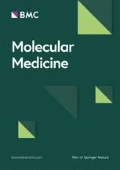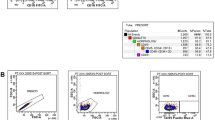Abstract
The malignant cells of classical Hodgkin’s lymphoma (cHL), Hodgkin and Reed-Sternberg (HRS) cells, appear to be derived from germinal center (GC) B cells in most cases of the disease. Apart from recent findings of constitutive activation of some transcription factors and autocrine stimulation by cytokine receptors, the mechanisms of malignant transformation in cHL still remain poorly understood. We performed a large scale gene expression study using serial analysis of gene expression (SAGE), comparing the cHL cell line L1236 and human GC B cells. Semiquantitative RT-PCR was used to confirm results from the SAGE and to analyze gene expression in 3 additional cHL cell lines. To investigate expression of some genes in cHL cases, we applied RT-PCR on microdissected HRS cells. In total, 464 genes showed a change in expression level of 5-fold or higher. For 12 genes (out of 177) identified as upregulated in L1236 cells, RT-PCR confirmed the SAGE results and also showed elevated expression in 3 other cHL cell lines. For 3 of the upregulated genes, expression by HRS cells in the tissue also was confirmed. Several of the differentially expressed genes may play a role in the pathogenesis of cHL because they represent potential oncogenes, such as rhoC, L-myc, and PTP4A, or transcription factors, such as ATF-5, ATBF1, and p21SNFT. The genes that showed significantly deregulated expression in HRS cells should be helpful not only for the identification of genes involved in the pathogenesis of cHL but also for discovering potential prognostic markers or therapeutic targets.



Similar content being viewed by others
References
Drexler HG. (1992) Recent results on the biology of Hodgkin and Reed-Sternberg cells. I. biopsy material. Leuk. Lymphoma 8:283–313.
Pinkus GS et al. (1997) Fascin, a sensitive new marker for Reed-Sternberg cells of Hodgkin’s disease. Evidence for a dendritic or B cell derivation? Am. J. Pathol. 150:543–62.
van den Berg A, Visser L, Poppema S. (1999) High expression of the CC chemokine TARC in Reed-Sternberg cells. A possible explanation for the characteristic T-cell infiltration Hodgkin’s lymphoma. Am. J. Pathol. 154:1685–91.
Küppers R. (2002) Molecular biology of Hodgkin’s lymphoma. Adv. Cancer Res. 84:277–312.
Stein H et al. (2001) Down-regulation of BOB.1/OBF.1 and Oct2 in classical Hodgkin disease but not in lymphocyte predominant Hodgkin disease correlates with immunoglobulin transcription. Blood 97:496–501.
Refer to https://doi.org/www.sagenet.org
Schwering I et al. (2003) Loss of the B lineage-specific gene expression program in Hodgkin and Reed-Sternberg cells of Hodgkin’s lymphoma. Blood 101:1505–12.
Kanzler H, Küppers R, Hansmann ML, Rajewsky K. (1996) Hodgkin and Reed-Sternberg cells in Hodgkin’s disease represent the outgrowth of a dominant tumor clone derived from (crippled) germinal center B cells. J. Exp. Med. 184:1495–505.
Marafioti T et al. (2000) Hodgkin and Reed-Sternberg cells represent an expansion of a single clone originating from a germinal center B-cell with functional immunoglobulin gene rearrangements but defective immunoglobulin transcription. Blood 95:1443–50.
Bräuninger A et al. (1999) Identification of common germinal-center B-cell precursors in 2 patients with both Hodgkin’s disease and Non-Hodgkin’s lymphoma. N. Engl. J. Med. 340:1239–47.
Küppers R et al. (2001) Common germinal-center B-cell origin of the malignant cells in two composite lymphomas, involving classical Hodgkin’s disease and either follicular lymphoma or B-CLL. Mol. Med. 7:285–92.
Marafioti T et al. (1999) Classical Hodgkin’s disease and follicular lymphoma originating from the same germinal center B cell. J. Clin. Oncol. 17:3804–9.
Irsch J et al. (2001) Class switch recombination was specifically targeted to immunoglobulin (Ig)G4 or IgA in Hodgkin’s disease-derived cell lines. Br. J. Haematol. 113:785–93.
Müschen M et al. (2000) Rare occurrence of classical Hodgkin’s disease as a T cell lymphoma. J. Exp. Med. 191:387–94.
Seitz V et al. (2000) Detection of clonal T-cell receptor gamma-chain gene rearrangements in Reed-Sternberg cells of classic Hodgkin disease. Blood 95:3020–4.
Cossman J et al. (1999) Reed-Sternberg cell genome expression supports a B-cell lineage. Blood 94:411–6.
Nacht M et al. (2001) Molecular characteristics of non-small cell lung cancer. Proc. Natl. Acad. Sci. U.S.A. 98:15203–8.
Zhang L et al. (1997) Gene expression profiles in normal and cancer cells. Science 276:1268–72.
Wolf J et al. (1996) Peripheral blood mononuclear cells of a patient with advanced Hodgkin’s lymphoma give rise to permanently growing Hodgkin-Reed Sternberg cells. Blood 87:3418–28.
Kanzler H et al. (1996) Molecular single cell analysis demonstrates the derivation of a peripheral blood-derived cell line (L1236) from the Hodgkin/Reed-Sternberg cells of a Hodgkin’s lymphoma patient. Blood 87:3429–36.
Hopken UE et al. (2002) Up-regulation of the chemokine receptor CCR7 in classical but not in lymphocyte-predominant Hodgkin disease correlates with distinct dissemination of neoplastic cells in lymphoid organs. Blood 99:1109–16.
Kapp U et al. (1999) Interleukin 13 is secreted by and stimulates the growth of Hodgkin and Reed-Sternberg cells. J. Exp. Med. 189:1939–46.
Bargou RC et al. (1997) Constitutive nuclear factor-κB-RelA activation is required for proliferation and survival of Hodgkin’s disease tumor cells. J. Clin. Invest. 100:2961–9.
Drexler HG. (1993) Recent results on the biology of Hodgkin and Reed-Sternberg cells. II. continuous cell lines. Leuk. Lymphoma 9:1–25.
Velculescu VE, Zhang L, Vogelstein B, Kinzler KW. (1995) Serial analysis of gene expression. Science 270:484–7.
Klein U et al. (2003) Transcriptional analysis of the B-cell germinal center reaction. Proc. Natl. Acad. Sci. U.S.A. 100:2639–44.
Pascual V et al. (1994) Analysis of somatic mutation in five B cell subsets of human tonsil. J. Exp. Med. 180:329–39.
Oka K, Mori N, Haimoto H, Kato K. (1990) Expression of enolases in T cell tumors and Hodgkin’s disease. Lab. Invest. 63:792–7.
Messineo C et al. (1998) Gene expression by single Reed-Sternberg cells: pathways of apoptosis and activation. Blood 91:2443–51.
Anwar F, Wood BL. (2000) CD44H and CD44V6 expression in different subtypes of Hodgkin lymphoma. Mod. Pathol. 13:1121–7.
Johnson EN, Druey KM. (2002) Functional characterization of the G protein regulator RGS13. J. Biol. Chem. 277:16768–74.
Zhou J et al. (2001) Characterization of RGS5 in regulation of G protein-coupled receptor signaling. Life Sci. 68:1457–69.
Spain BH et al. (1996) Two human cDNAs, including a homolog of Arabidopsis FUS6 (COP11), suppress G-protein- and mitogen-activated protein kinase-mediated signal transduction in yeast and mammalian cells. Mol. Cell Biol. 16:6698–706.
Bachner D, Sedlacek Z, Korn B, Hameister H, Poustka A. (1995) Expression patterns of two human genes coding for different rab GDP-dissociation inhibitors (GDIs), extremely conserved proteins involved in cellular transport. Hum. Mol. Genet. 4:701–8.
Scherle P, Behrens T, Staudt LM. (1993) Ly-GDI, a GDP-dissociation inhibitor of the RhoA GTP-binding protein, is expressed preferentially in lymphocytes. Proc. Natl. Acad. Sci. U.S.A. 90:7568–72.
Saha S et al. (2001) A phosphatase associated with metastasis of colorectal cancer. Science 294:1343–6.
Clark EA, Golub TR, Lander ES, Hynes RO. (2000) Genomic analysis of metastasis reveals an essential role for rhoC. Nature 406:532–5.
Barrett J, Birrer MJ, Kato GJ, Dosaka-Akita H, Dang CV. (1992) Activation domains of L-Myc and c-Myc determine their transforming potencies in rat embryo cells. Mol. Cell Biol. 12:3130–7.
Lah TT, Kos J. (1998) Cysteine proteinases in cancer progression and their clinical relevance for prognosis. Biol. Chem. 379:125–30.
Menard S, Tagliabue E, Colnaghi MI. (1998) The 67 kDa laminin receptor as a prognostic factor in human cancer. Breast Cancer Res. Treat. 52:137–45.
Goodison S, Urquidi V, Tarin D. (1999) CD44 cell adhesion molecules. Mol. Pathol. 52:189–196.
Boutros M, Mlodzik M. (1999) Dishevelled: at the crossroads of divergent intracellular signaling pathways. Mech. Dev. 83:27–37.
Aryee DN et al. (1996) Variability of nm23-H1/NDPK-A expression in human lymphomas and its relation to tumour aggressiveness. Br. J. Cancer 74:1693–8.
Ikeda H et al. (1997) Characterization of an antigen that is recognized on a melanoma showing partial HLA loss by CTL expressing an NK inhibitory receptor. Immunity 6:199–208.
Iacobelli M, Wachsman W, McGuire KL. (2000) Repression of IL-2 promoter activity by the novel basic leucine zipper p21SNFT protein. J. Immunol. 165:860–8.
Peters CS et al. (2001) ATF-7, a novel bZIP protein, interacts with the PRL-1 protein-tyrosine phosphatase. J. Biol. Chem. 276:13718–26.
Morinaga T, Yasuda H, Hashimoto T, Higashio K, Tamaoki T. (1991) A human alpha-fetoprotein enhancer-binding protein, ATBF1, contains 4 homeodomains and seventeen zinc fingers. Mol. Cell Biol. 11:6041–9.
Li X, Commane M, Jiang Z, Stark GR. (2001) IL-1-induced NFκ B and c-Jun N-terminal kinase (JNK) activation diverge at IL-1 receptor-associated kinase (IRAK). Proc. Natl. Acad. Sci. U.S.A. 98:4461–5.
Bolin LM et al. (1997) HNMP-1: a novel hematopoietic and neural membrane protein differentially regulated in neural development and injury. J. Neurosci. 17:5493–502.
Guzman-Rojas L et al. (2000) PRELI, the human homologue of the avian px19, is expressed by germinal center B lymphocytes. Int. Immunol. 12:607–12.
Peattie DA et al. (1992) Expression and characterization of human FKBP52, an immunophilin that associates with the 90-kDa heat shock protein and is a component of steroid receptor complexes. Proc. Natl. Acad. Sci. U.S.A 89:10974–8.
Shaulian E, Karin M. (2001) AP-1 in cell proliferation and survival. Oncogene 20:2390–2400.
Küppers R et al. (2003) Identification of Hodgkin and Reed-Sternberg cell-specific genes by gene expression profiling. J.Clin. Invest. 111:529–37.
Jox A et al. (1999) Somatic mutations within the untranslated regions of rearranged Ig genes in a case of classical Hodgkin’s disease as a potential cause for the absence of Ig in the lymphoma cells. Blood 93:3964–72.
Buckbinder L et al. (1997) The p53 tumor suppressor targets a novel regulator of G protein signaling. Proc. Natl. Acad. Sci. U.S.A. 94:7868–72.
Aron B, Hall A. (2002) Rho GTPases in Transformation and Metastasis. Adv. Cancer Res. 84:57–80.
Cates CA et al. (1996) Prenylation of oncogenic human PTP(CAAX) protein tyrosine phosphatases. Cancer Lett. 110:49–55.
Diamond RH, Cressman DE, Laz TM, Abrams CS, Taub R. (1994) PRL-1, a unique nuclear protein tyrosine phosphatase, affects cell growth. Mol. Cell Biol. 14:3752–62.
Kaspar P et al. (1999) Myb-interacting protein, ATBF1, represses transcriptional activity of Myb oncoprotein. J. Biol. Chem. 274:14422–8.
Berry FB et al. (2001) Positive and negative regulation of myogenic differentiation of C2C12 cells by isoforms of the multiple homeodomain zinc finger transcription factor ATBF1. J. Biol. Chem. 276:25057–65.
Miura Y et al. (1995) Cloning and characterization of an ATBF1 isoform that expresses in a neuronal differentiation-dependent manner. J. Biol. Chem. 270:26840–8.
Mathas S et al. (2002) Aberrantly expressed c-Jun and JunB are a hallmark of Hodgkin lymphoma cells, stimulate proliferation and synergize with NF-κB. EMBO J. 21:4104–13.
Acknowledgments
This work was supported through the Deutsche Forschungsgemeinschaft by SFB502 and a Heisenberg award to RK. We are grateful to Yvonne Blum, Michaela Fahrig, Christine Gerhardt, and Tanja Schaffer for excellent technical assistance, to Berit Jungnickel for stimulating discussions, and to Carel van Noesel for critically reading this manuscript.
Author information
Authors and Affiliations
Corresponding author
Rights and permissions
About this article
Cite this article
Schwering, I., Bräuninger, A., Distler, V. et al. Profiling of Hodgkin’s Lymphoma Cell Line L1236 and Germinal Center B Cells: Identification of Hodgkin’s Lymphoma-specific Genes. Mol Med 9, 85–95 (2003). https://doi.org/10.1007/BF03402041
Received:
Accepted:
Published:
Issue Date:
DOI: https://doi.org/10.1007/BF03402041




